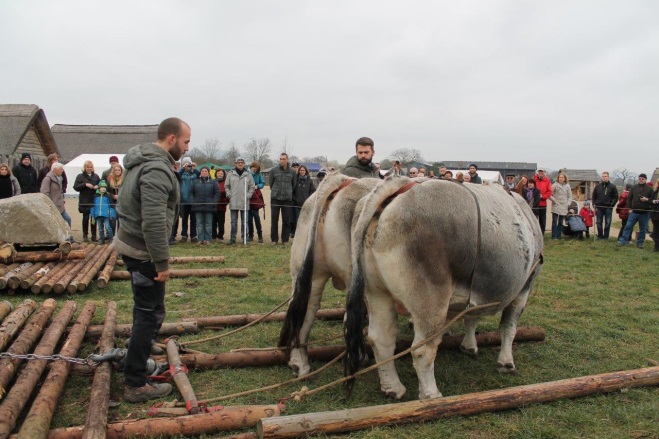Scene 2 at Lauresham Open-Air Laboratory in Kloster Lorsch, a UNESCO world heritage site.

In February 2016, the German Oxdrivers’ Group met in Berlin in the Dahlem Domain to watch as farm manager Astrid Masson moved a megalith with single cow-power – Emma with her calf Elsa in tow – showing us that, in comparison, manpower looked like a good joke. She has worked with the archaeologist Eva Rosenstock on experimental reconstitutions of cattle draft in the light of theories on field clearing during the Neolithic penetration of agricultural technologies in Europe.

The 2017 February meeting of the group gave a chance for Claus Kropp at the Lauresham Open-Air Laboratory in Kloster Lorsch to harness his 8-year-old, 800-kg Raetian Grey oxen, David and Darius, to try the experiment out with two megaliths, one weighing in at 1.1 and the other at 1.7 tonnes.
Lauresham is in the EXARC network of open-air experimental archaeology museums whose goals involve reconstituting both the built environment, such as the rather mysterious pit-houses, as well as the village lifeways and agricultural practices with the tools, implements and vehicles corresponding to a farming operation excavated at the Kloster Lorsch site, a Benedictine abbey founded in the Carolingian period.

David and Darius are experienced workers and think nothing of pulling about a 150-kg log, but how would they react to two megaliths set on a raft-like sledge on wooden rollers surrounded by curious onlookers? – just the way Astrid’s cow did: what is all this to-do about?, let’s just do the job, and the oxen did. A single ox hardly budged the 1.1 t block, but the pair literally set the 1.7 stone in flight, as it built up so much momentum that it tumbled off the sledge. The museum handlers borrowed the local forklift to set it back on the sledge to continue the experiment the next day.

This is an important point for all the experimenters – how to do that first step without calling on current technology. Of course, they were taking notes at the same time, checking the draft force meter with each try and comparing it to the happy, if hilarious manpower effort that followed, to set against the data gleaned in Berlin the year before, and make new observations: simplify the start-off by setting the wooden rollers in order of decreasing diameter to give the whole kinetic ensemble a slight slope, then placing the two “rails” closer together to allow them more leeway to move about under the pressure. Finally, the last touch was to get the two oxen to pull with exactly the same force.

When not having two megaliths to sink their teeth into, David and Darius are hardly out of work, as they begin their regular farming and transport programme as soon as the spring weather allows – log-clearing, carrying firewood and kindling in one of the replica farm carts or wagons, preparatory harrowing for broadcast sowing some 2500 square meters, followed by a lighter harrowing to cover the seed.

In 2016, this early tillage programme showed the Lauresham team that the pair could get tired and needed a back-up, so they have trained their cows and younger oxen to step in for lighter work – this gives the two Ds a chance to rest up and avoid any risk of burn-out.

In our own age of animal welfare concerns, museum staff have no intention of making the animals perform according to a medieval working schedule and it is precisely the differences that enable so many conversations with the public.

First, the handlers show visitors a head yoke replica matching those well attested for the period in the area, then explain that they will not use it, because it is illegal and considered too uncomfortable (except for private oxdrivers, as some in the Working Group who want to show harness authentic for their own regions in festive events and demonstrations). At Lauresham, the oxen and cows are yoked to the 3-pad collar raised to technical perfection in the 1930s to underwrite best practices and highest yields for the many small farmers in Germany. The contrast between old and new lets the handlers explain how cattle draft developed from pre-history right up to today, when it is a vital component in farming in many communities in the world. And no one doubts the power of attraction of working animals for a museum’s visitors, so… David and Darius are on offer in the museum shop in a smaller, softer version.


References:
German Oxdrivers’s Group website
Kloster Lorsch Lauresham website
Rosenstock, Eva & Masson, Astrid & Zich, Bernd. (2019). Moraines, megaliths and moo: Putting the prehistoric tractor to work.
